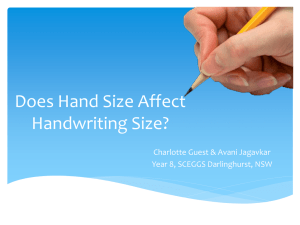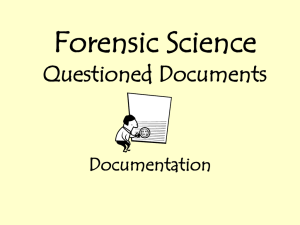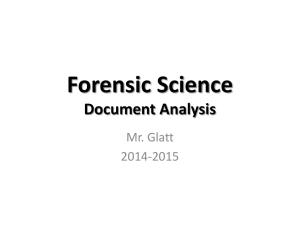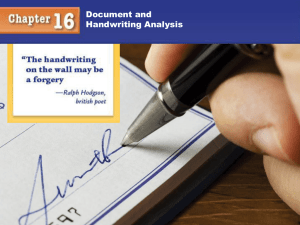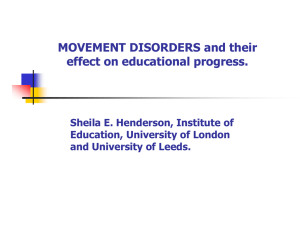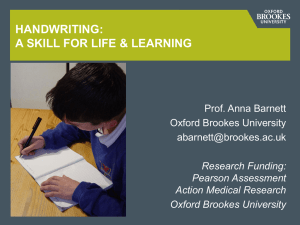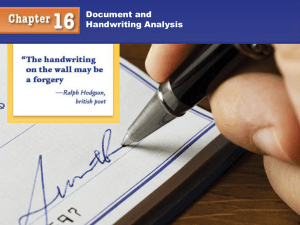Handwriting Analysis, Forgery, and Counterfeiting
advertisement
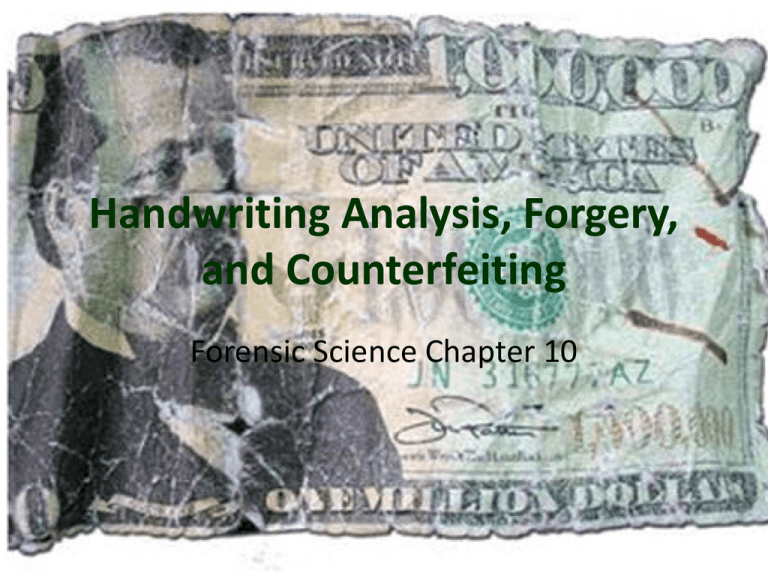
Handwriting Analysis, Forgery, and Counterfeiting Forensic Science Chapter 10 Introduction • Document analysis – examination and comparison of questioned documents with known material. Experts establish the authenticity of the documents and detect any changes, erasures, or obliterations that may have occurred. • Questioned documents – any signature, handwriting, typewriting, or other written mark whose source or authenticity is in dispute or uncertain. Exs: checks, certificates, wills, passports, licenses, money, letters, contracts, suicide notes, receipts, lottery tickets. • Document Expert – specially trained person who scientifically analyzes handwriting and other features in a document, often to detect changes from the original. This is not the same as a graphologist. A graphologist studies the personality of the writer based on handwriting samples. Graphology is not a widely accepted part of forensics. History • Like fingerprints, every person’s handwriting is unique and personalized. Handwriting is difficult to disguise or forge and analysis can provide a useful tool in forensics in excluding persons when determining a match between known material (exemplar). • 1930s, handwriting played a great role in the trial of Bruno Richard Hauptmann for the kidnapping and murder of the son of Charles Lindbergh. Analysis of the many ransom notes, along with samples, led to Hauptmann’s conviction and execution. Hauptmann’s involvement is still being questioned due to handling of the documents. • Courts have not always accepted handwriting analysis as a creditable form of evidence. In 1999, the U.S. Court of Appeals determined that handwriting analysis qualified as a form of expert testimony. Handwriting and Forgery • Everyone’s handwriting exhibits natural variation due to several factors. Pen vs. pencil, marker, or crayon, mood, age, and speed can all contribute to the difference we notice in our own handwriting. • Despite these minor variations, each person has a unique handwriting style. Slant, curl, and height can distinguish our identity. Adults show slight variation (the brain has been trained) because the characters are formed as a result of habit. (Try this, write “I smell good food” while looking at your paper. Now write it again without looking. The handwriting should still be very similar, maybe only crooked. Neat, huh!) Everyone’s handwriting shows natural variations. Here are 6 of the 12 major, specific traits. The traits are functions of formatting or of letter or line form. Here are the other 6 of the 12 major, specific traits Forensic Science: Fundamentals & Investigations, Chapter 10 5 Characteristics of Handwriting • Handwriting experts examine 12 major categories of exemplars. These are functions of letter form, line form, and formatting. • Letter form includes the shape of letters, curve of letters, the angle or slant of letter, proportional size of letters, and the use and appearance of connecting lines between letters. (Are “i”s dotted and “t”s crossed?) • Line form includes the smoothness of letters and the darkness of the lines on the upward compared to the downward stroke. Line form is influenced by speed and pressure and occasionally the choice of writing utensil. • Formatting includes the spacing between letters, the spacing between words and lines, the placement of words on a line, and the margins. Line quality Purposely distorted Spacing (excessive) Low-skilled writer Four signatures from same person demonstrating variation High-skilled writer Handwriting Examination Analyzing a Handwriting Sample • The goal of forensic handwriting analysis is to answer questions about a suspicious document and determine authorship using a variety of scientific methods. “Two writings are the product of one person if the similarities…are…[unique] and there are no fundamental unexplainable differences.” • Forgeries – documents made, adapted, or falsified with the intention of deceiving someone. • There are 3 basic steps in the process of analyzing a handwriting sample. 1: the questioned document and the standards (exemplars) are examined and detectable characteristics are recorded. A sample should be obtained without letting the person know what for if possible. Great exemplars would be letters, greeting cards, and notes. 2: Characteristics of the questioned item are compared with the known standard. 3: Experts determine which characteristics are valuable for drawing a conclusion about the authenticity and authorship of the questioned document. • Obvious differences between a standard and a questioned document would show different authors. Such samples can be visually eliminated without ever having to assess the list of handwriting characteristics. • Similarities do not guarantee common authorship. Sometimes characteristics of one person can occur in another person’s handwriting. • Document experts must take into account a great number of factors and a statistically significant repetition of similarities in their analyses. Pros can tell if a person has tried to disguise their handwriting or copy someone else’s. • 1: A suspect should not be shown the questioned document 2: a suspect should not be given any instructions about punctuation or spelling 3: the pen and paper should be similar to that of the question document. Technology Used in Handwriting Analysis • Initial comparisons are done with the naked eye, a handheld lens, or a microscope. Specialized equipment can reveal minor details about how a document was changed. Infrared spectroscope can determine if more than one kind of ink was used on the document (different inks, different light reflections). • Biometric Signature Pads – a new research tool, has been designed for identity authentification. This computer pad recognizes your signature based on speed, pressure and rhythm of signing your name. • Computer Analysis – this can be faster and more objective. Pressure is subjective, but when placed in a computer, the pen pressure can be objectively analyzed by the shading in the pixels. The Forensic Information System for Handwriting (FISH) database is maintained/used by the Secret Service. Documents are scanned in and it can be determined that no two writers pen their words exactly the same nor do they have the same combination of handwriting characteristics. Handwriting in the Courtroom • After being expertly analyzed, the expert will prepare a witness report and both the defense and the prosecutor will ask questions about the analysis. The analyzer, now on the stand as an expert witness (and expert in handwriting) will answer questions about document comparisons and how guilt or innocence was implied. Many samples will be shown to the jury. Shortcomings in Handwriting Analysis •One limitation is that the quality of the standards obtained often determines the quality of a comparison analysis. Another limitation could be the effects of mood, age, drugs, fatigue, and illness on a person’s handwriting. Analyzers have to be certified. The American Board of Forensic Document Examiners is one establishment that offers such training for certification. Handwriting is considered a reproducible and peer-reviewed scientific process. Forgery • When a material gain, such as money, accompanies a forgery, it is called fraudulence. Generally, the primary purpose of forging something is to profit from the fake or alteration. • Check Forgery – Approx. $27 million in illegitimate checks are cashed each day. Criminals can alter or acquire checks in may ways like ordering someone else’s checks from a deposit slip, directly altering a check, intercepting someone’s check, altering it, and cashing it, or creating forged checks from scratch. In their attempt to prevent check fraud, many banks hope to eventually eliminate checks altogether. Fig. 10-8 in your book has methods to prevent check fraud. Preventing Check Forgery These are some methods used to prevent check forgery: Forensic Science: Fundamentals & Investigations, Chapter 10 13 • Literary Forgery This refers to a piece of writing, such as an historic letter or manuscript. • The best literary forgers try to duplicate the original documents, so the materials used are similar to those used in the original document. They do this by collecting old paper or old books. Because the process of papermaking has changed, it is essential for forgers to use aged paper to pass the microscopic examination tests. Inks have also changed, so intelligent forgers would mix their own inks from material that would have been used at the time. Writing utensils and writing styles from the era are also considered. • Chemicals may be added to the paper to age both the paper and the ink. In the 1980s, Mark Hofmann made several forgeries including 116 pages of a “lost” Mormon document. In the planning for a second forged Mormon document, Hofmann set off three bombs in a building. The first killed an innocent Mormon business leader and the third accidentally went off in his car, attracting police attention. Hofmann is currently serving a life sentence. Counterfeiting • When false documents or other items are copied for the purpose of deception, it is called counterfeiting. Travelers’ checks, savings bonds, and currency are among the most often counterfeited items. Other items could be food stamps, postage stamps, or coins. • In the past, with access to a scanner and color printer, it was not very difficult to create counterfeit currency. Now the Secret Service with the aid of technology has added features to paper currency that, when scanned, prevent the currency from being copied. Counterfeit money also feels different because real money is printed on special paper. The #1 way people catch fakes is because it doesn’t feel right. Detecting Counterfeit Currency • Counterfeit detecting pens are inexpensive special pens/markers containing the element iodine. When they come in contact with a counterfeit bill, the paper marked with the pen will change color to a bluish-black. This is because of starch, found in regular printer paper. Real money does not contain starch but has a different fiber. When the pen is marked on real money, it’ll leave a pale yellow-brown line that fades quickly. • Pen manufacturers claim the pen to have a 98% accuracy, but some counterfeiters will bleach $1 bills to have the correct paper to print off larger bills. There is currently a global movement to change to polymer money, a type of plastic money because it’s much more difficult to counterfeit and less expensive to make. • • • • • • • • 1.The portrait is more lifelike than on counterfeit money. 2.There are fine lines, smooth and unbroken lines printed behind the president and behind the building on the reverse. 3.There is a polymer thread woven in the bill. The thread in the $100 bill reads "USA 100" and the $50 bill reads "USA 50". The thread can't be reproduced with copiers or printers but is visible when the bill is held up to a light or appears yellow when in ultraviolet light. Genuine bills also have red and blue threads embedded in the paper. On counterfeit money the lines look like they're printed on the paper but on genuine bills the lines appear to be in the paper. 4.There is a watermark or "shadow" to the right of the face on the bill. It isn't visible unless the bill is held up to the light. 5.Color shifting ink is used for the number in the lower right hand corner on the front of the bill. The ink appears green until the bill is held at an angle, then the ink looks black. The ink is also "never dry" ink, which means that it can be rubbed off. Sometimes; however, the ink on counterfeit money can also rub off. On the $50, the number 50 is printed in large print. 6.On the $100 bill microprinted words are written around the portrait. To the naked eye it looks like a black line but under a microscope the words "The United States of America" can be read. On the $50 bill, "50" is written around the portrait and "United States of America" is printed in Grant's collar. 7.Genuine bills have the Federal Reserve and Treasury seals. The saw-tooth points on the seal are clear, distinct, and sharp. The seals on counterfeit money may have uneven, blunt, or broken points. 8.Along with the seals on each bill there's a serial number printed in the same color ink as the seal. Numbers and letters are evenly spaced. Verifying Authentic Currency Some features found in the new series bills: Forensic Science: Fundamentals & Investigations, Chapter 10 19
